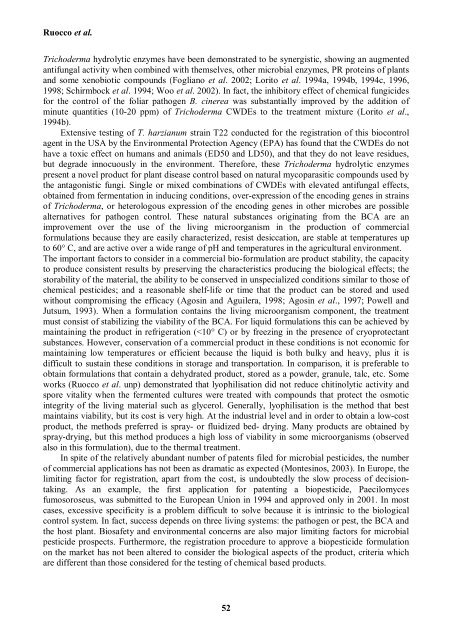Classical and augmentative biological control against ... - IOBC-WPRS
Classical and augmentative biological control against ... - IOBC-WPRS
Classical and augmentative biological control against ... - IOBC-WPRS
Create successful ePaper yourself
Turn your PDF publications into a flip-book with our unique Google optimized e-Paper software.
Ruocco et al.<br />
Trichoderma hydrolytic enzymes have been demonstrated to be synergistic, showing an augmented<br />
antifungal activity when combined with themselves, other microbial enzymes, PR proteins of plants<br />
<strong>and</strong> some xenobiotic compounds (Fogliano et al. 2002; Lorito et al. 1994a, 1994b, 1994c, 1996,<br />
1998; Schirmbock et al. 1994; Woo et al. 2002). In fact, the inhibitory effect of chemical fungicides<br />
for the <strong>control</strong> of the foliar pathogen B. cinerea was substantially improved by the addition of<br />
minute quantities (10-20 ppm) of Trichoderma CWDEs to the treatment mixture (Lorito et al.,<br />
1994b).<br />
Extensive testing of T. harzianum strain T22 conducted for the registration of this bio<strong>control</strong><br />
agent in the USA by the Environmental Protection Agency (EPA) has found that the CWDEs do not<br />
have a toxic effect on humans <strong>and</strong> animals (ED50 <strong>and</strong> LD50), <strong>and</strong> that they do not leave residues,<br />
but degrade innocuously in the environment. Therefore, these Trichoderma hydrolytic enzymes<br />
present a novel product for plant disease <strong>control</strong> based on natural mycoparasitic compounds used by<br />
the antagonistic fungi. Single or mixed combinations of CWDEs with elevated antifungal effects,<br />
obtained from fermentation in inducing conditions, over-expression of the encoding genes in strains<br />
of Trichoderma, or heterologous expression of the encoding genes in other microbes are possible<br />
alternatives for pathogen <strong>control</strong>. These natural substances originating from the BCA are an<br />
improvement over the use of the living microorganism in the production of commercial<br />
formulations because they are easily characterized, resist desiccation, are stable at temperatures up<br />
to 60° C, <strong>and</strong> are active over a wide range of pH <strong>and</strong> temperatures in the agricultural environment.<br />
The important factors to consider in a commercial bio-formulation are product stability, the capacity<br />
to produce consistent results by preserving the characteristics producing the <strong>biological</strong> effects; the<br />
storability of the material, the ability to be conserved in unspecialized conditions similar to those of<br />
chemical pesticides; <strong>and</strong> a reasonable shelf-life or time that the product can be stored <strong>and</strong> used<br />
without compromising the efficacy (Agosin <strong>and</strong> Aguilera, 1998; Agosin et al., 1997; Powell <strong>and</strong><br />
Jutsum, 1993). When a formulation contains the living microorganism component, the treatment<br />
must consist of stabilizing the viability of the BCA. For liquid formulations this can be achieved by<br />
maintaining the product in refrigeration (

















